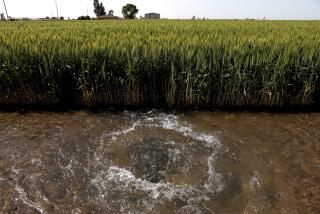Politics and water conservation
- Share via
In June 2009, an ordinance limiting lawn and garden watering with sprinklers to two days a week took effect in Los Angeles. Citywide water consumption dropped by more than 20%.
Yet, 13 months later, the ordinance that pushed Los Angeles to the fore of the Western water conservation movement is about to be gutted, having become collateral damage in a roiling brawl over rate hikes and green energy between the City Council and the mayor’s office.
On July 6, the City Council sent the utility a neutered version of the lawn ordinance that would allow watering an extra day a week. Last week, browbeaten Department of Water and Power commissioners quietly rubber-stamped it. What is being passed off as a tweak looks more like a death knell for one of the best collective environmental efforts made by the citizens of Los Angeles.
The ordinance was instituted for many reasons — regionwide drought, water delivery cuts to Southern California and common sense on the part of then-DWP General Manager H. David Nahai.
Nahai went after lawns because that’s where the water is. Roughly half of the water used in Los Angeles goes outdoors, most of that on turf grass, a plant that needs almost constant life support outside its traditional range in rainy Britain.
But not everyone supported water conservation in our frontyards. San Fernando Valley Councilman Greig Smith argued that the ordinance turned lawns brown, and last September, he began publicly flouting it by watering his own yard more frequently than the law allowed. That stunt was overshadowed by a series of highly publicized water main breaks — one so spectacular that the resulting sinkhole swallowed the front end of a fire truck.
We will never know if the leaks of September 2009 were caused by the fluctuations in pressure from the two-day lawn watering regimen. The DWP has historical charts showing that the rate of bursts was nothing out of the ordinary. But last spring, when a USC engineering group released a report arguing that the leaks were indeed exceptional and that the ordinance caused them, the DWP was too embattled to object.
The ordinance’s godfather, Nahai, was gone as general manager. So was his successor, S. David Freeman. The DWP sent a new draft ordinance to the City Council incorporating a USC recommendation to spread out lawn watering days. Under this, half the city would have watered on Mondays and Thursdays and half on Tuesdays and Fridays.
The City Council sat on the proposed fix until long after the water department could reasonably be expected to publicize any new rule before the hottest days of summer. And when the council finally acted, it rejected the DWP proposal, instead sending back to the utility a plan by Smith to allow watering three days a week. Cowed DWP commissioners rubber-stamped the proposal last week.
On paper, the Smith plan looks better. The original ordinance allowed automated sprinklers to run two days a week for a total of 30 minutes. The Smith plan allows sprinklers to run three days a week for a total of 24 minutes. Less water! More savings!
Smith sold the plan arguing that the original ordinance led to large pressure fluctuations on the two legal watering days. By having half the city watering on three days and the other half on another three days, pressure would be kept more even over six days. Better for pipes!
But the Smith plan will save water only if people who water more days observe the fine print about watering for less time. This will be unenforceable. Who among us times our neighbor’s sprinklers?
By contrast, the original ordinance was perfectly tailored to the collective honor system. With such a narrow window for watering, violators were conspicuous. Compliance became a testament of civic pride, a spirit so strong that last year, fewer than 200 fine-carrying citations were issued as Angelenos conserved enough water to supply Long Beach, Santa Monica, Burbank and Beverly Hills combined.
Will lawns be healthier? Council President Eric Garcetti said he supported the Smith plan because his wife “who is a big gardener for a year and a half” told him that “plants die with only two waterings a week.”
But Bob Perry, professor emeritus of landscape architecture at Cal Poly Pomona, disagrees. “Watering twice a week for 15 minutes during the cool hours is better than three times at eight minutes,” he wrote in response to an e-mail query. “This will result in deeper moisture infiltration into the soil and less water loss due to evaporation.”
Will the Smith plan be better for the city’s pipes? The DWP engineers who oversee them say no, while a group of academics from USC says yes. The only take-home truth about pipes in this spectacle has been that they were the murder weapon as city politics killed the original ordinance.
As the law behind L.A.’s conservation milestone joins the steadily rising bone pile of DWP general managers to fall foul of the feud between the City Council and the mayor, the scofflaw Smith has been rewarded. A plan that may or may not work to alleviate water main breaks is being implemented by the City Council too late for the DWP to effectively get the message out. Finally, the steadily ruinous notion that summer lawns should be green in Los Angeles is being reinforced by promoters of a new law that won’t achieve that — unless you cheat.
Emily Green writes the Dry Garden column for The Times. She is completing a book on water in the Great Basin Desert. Her website is chanceofrain.com.
More to Read
Sign up for Essential California
The most important California stories and recommendations in your inbox every morning.
You may occasionally receive promotional content from the Los Angeles Times.













